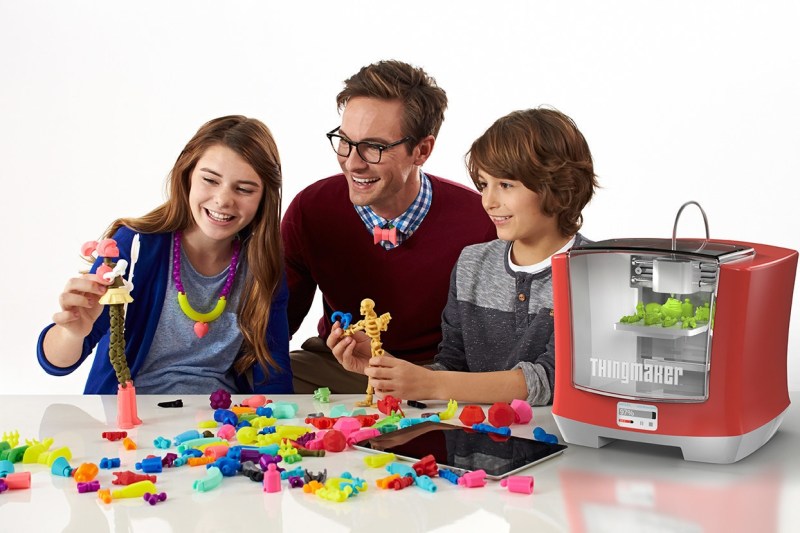
Mattel holds a fond place in most people’s hearts as they made many of the toys we played with as kids. You might remember the Thingmaker, which was essentially an Easy Bake Oven with some goop and molds that let you make rubbery creatures. But back in 2016, Mattel had an aborted attempt to bring 3D printing to kids under the Thingmaker label. You can see a promo video of the device below. You might not have seen one in real life, though. The product was delayed and eventually canceled. Even so, we frequently see press releases for “kids printers” and we’ve been wondering, should this be a thing?
Definitions
Let’s define kids. Of course, at some age, a kid interested in 3D printing should have a 3D printer in the same way they might have a guitar if they are interested in playing the guitar. But you probably don’t give your 9-year-old a guitar and hope it catches on. So by kid, in this context, we really mean pre-teen or earlier. We also aren’t even considering resin printers as they are, today, messy and toxic. We’re talking garden-variety FDM printing with relatively safe materials like PLA.
You might think no one thinks you should have your 9-year-old operating a 3D printer. Really? Toybox, recommends its 3D printer for children 5 and up, with adult supervision. Granted, with adult supervision it is possible, but we aren’t sure that’s very wise.
The Pros
Of course, we are always in favor of things that give kids something technical to spark their imagination. A 3D printer can teach many things: patience for slow prints and jams, electronics, mechanics, polymer chemistry, and 3D modeling. All of those could lead to marketable job skills down the road.
There are worse hobbies a kid could have. However, there are some negatives, too. Like many things, your approach is everything. You can help a kid form a lifelong interest or completely ruin any chance of them wanting to do any sort of technology.
The Cons
Printers are not as safe as you’d like. There is a very hot tip, maybe a heated bed, and possibly fumes and chemicals. Of course, with adult supervision, none of that is a deal breaker. Possibly a larger problem is maintenance. Cheap consumer-grade printers tend to need work. Things wear out or need lubrication. Belts wear or need tightening. Now, granted, if Mom’s a Hackaday reader, she can probably do all of these things, but it is going to quickly erode a child’s excitement for the process.
Another issue is expectations. Think of telescopes. A kid sees a telescope in a big box store and imagines using it to see the amazing rings of Saturn and the spot on Jupiter. But with a cheaply-made 2.5 inch lens, you are lucky to see smudges of planets, badly twinkling stars, and — maybe — slightly better views of the moon. How many astronomy buffs have been disenchanted by a cheap first telescope?
Printers for kids are usually not expensive industrial-quality machines. They aren’t going to print in multiple materials and colors. They are slow and won’t print very large models. There are only so many little plastic widgets you can produce before it gets boring.
So What is the Answer?
We’ve often said, having a 3D printer is not far away from being like owning a drill press. Not everyone has a drill press, but if you have one, no one thinks twice about it. Just like kids take shop classes, we think 3D printer classes have their place either in schools, libraries, or hackerspace camps.
Think of the analogy to programming. Everyone these days uses a computer, and kids who know something about how computers work probably have a competitive advantage, but that doesn’t mean you teach every kid software engineering in C++ using real-time operating systems. In the future, understanding how 3D printing works might be of value, assuming 3D printing in 20 years looks anything like 3D printing today. But knowing how to level a bed on an Ender 3 is probably not that helpful.
One way to address this is to have kids design things and have them made via a third-party service or even a parent. Tools like Tinkercad are very easy for kids to pick up and it unleashes their creativity. With a little coaching, learning what to expect from 3D printing and what kind of things to avoid when making 3D-printed parts is probably a skill for the future. Older kids that might be in a shop class, might very well take a supervised 3D printing class. But only a few kids really need their own 3D printer and the ones that do could probably make do with a normal printer, not one specifically aimed at kids.
If you are contemplating running a class for kids, you might find the video from a seasoned “Innovative Arts” teacher in the video below.
Over to You
So what do you think? What’s the youngest kid you’ve had operating a 3D printer? How did it go? Would you try younger or not? Tell us what you think in the comments. If you think your school or library can’t afford a 3D printer, there are options although commercial printers aren’t much more expensive these days. You can actually work with kids without much hardware at all.
0 Commentaires